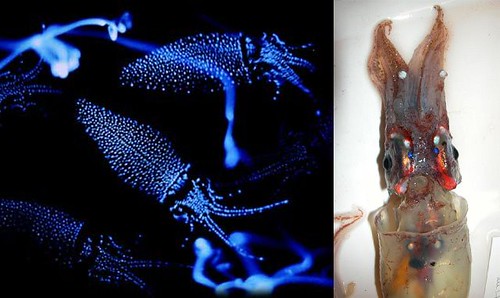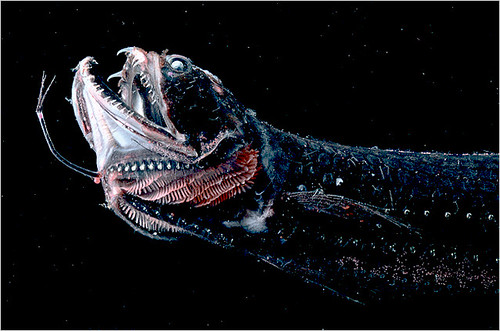Bioluminescence is the light produced from a chemical reaction that occurs inside a living organism. The emission is a "cold light," named as such since less than 20% of it generates thermal radiation. Although multiple land animals have developed the trait (fireflies, glowworms, click beetles, fungi, etc.), it's not in particularly high demand in their evolutionary process. However, the deep sea is a vast open space devoid of sunlight. And when there's nowhere to run to, baby, and certainly nowhere to hide, you've got to make do with your own body.
Some deep sea predators need simply to look up, where the minimal amount of sunlight makes enough of a change in light value to expose silhouettes of the prey swimming above. To avoid becoming a succulent snack, creatures like the firefly squid, hatchetfish, and lightfish have developed rows of photophores (light-producing organs) that produce the same color and intensity of blue as the daylight above. The counterillumination breaks up the silhouette edges and allow them to disappear into the backdrop.

Lightfish, commonly called bristlemouths, are usually black with under-body photophores, and can grow anywhere from 2 to 30cm long.

The Sparkling Enope, or Firefly Squid, is usually found in the Pacific Ocean at depths of 600-1200ft.
Blue light is the most common color emitted in marine life, as it travels furthest in seawater and is the only shade visible to an abundance of the deep sea organisms. The dragonfish took advantage of this by evolving the ability to emit and perceive a much longer wavelength - red light. Besides being able to sneak up on unsuspecting prey with advanced night vision goggles, it also managed to retain the ability to create blue light, in order to switch from lurker-mode to high-beam headlight, and to lure prey with the fishing-bait barbel dangling from its lower jaw.

Mmmm, deelicious squid...
There's so much more to come!

Wow, I can't believe I've known about bioluminescence for so long without ever understanding its purpose. Haha, blending in with the backlighting! Does the ability to emit red light make the dragonfish virtually invisible to other creatures who haven't yet developed the ability to perceive it?
ReplyDeleteYes! Lots of deep sea fish are only sensitive to blue light, which means that their eyes can't perceive any other wavelengths - so dragonfish are like ghosts when their red lights are on! ...Except of course, to other dragonfish. Then the light is used for looking sexy and finding a mate.
ReplyDelete